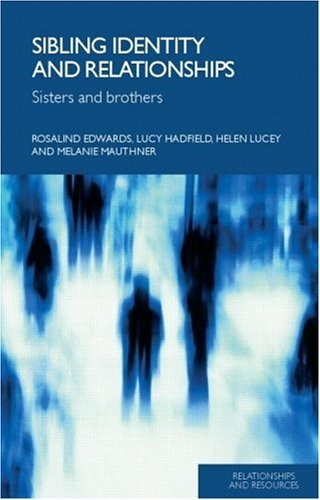Sibling Identity and Relationships (Relationships and Resources S.)
Hadfield, Lucy, Lucey, Helen, Mauthner, Melanie L. and Edwards, Rosalind
Routledge, London
2006
0415339308 (pb)
 Sibling Identity and relationships asks what it means to be a sister or brother, a relationship which has tended to be sidelined in foregrounding parental-child relations. It charts the emotional and social facets to their ongoing constructions, shifts and changes. The authors interestingly combine social constructionist and psychodynamic perspectives as a means of discussing complex, shared, emotions, such as sibling 'projective identification', connection and separation. Such emotions are seen to be shaped by and respond to varying social conditions and circumstances. In answering the question 'why siblings?' the authors point to the significance of siblings for our sense of self, whether that self be constructed as similar to or vastly different from our sisters and brothers.
Sibling Identity and relationships asks what it means to be a sister or brother, a relationship which has tended to be sidelined in foregrounding parental-child relations. It charts the emotional and social facets to their ongoing constructions, shifts and changes. The authors interestingly combine social constructionist and psychodynamic perspectives as a means of discussing complex, shared, emotions, such as sibling 'projective identification', connection and separation. Such emotions are seen to be shaped by and respond to varying social conditions and circumstances. In answering the question 'why siblings?' the authors point to the significance of siblings for our sense of self, whether that self be constructed as similar to or vastly different from our sisters and brothers.
Each author positions herself by disciplinary background as well as by sibling status: in the rehearsal and displacement of oldest, middle and youngest child 'syndrome' myths, many other readers may well consider repeated remarks and placements by school teachers in assessing you as someone's sister or brother, assuming you to be a troubling or saintly replicate. This book is remarkable for its interdisciplinary approach and for foregrounding young people's opinions and experiences, vividly highlighting the way that they negotiate and challenge their sibling status through markers of 'sameness' and 'difference'. Such markers are not just achieved and resisted by young people alone but are created and confirmed in a range of social locations, with gendered, classed and ethnic specificities. The use of family 'circle maps' seems to have been used effectively to draw out these testimonies but it would have been useful to know if this method differed according to interviewees' ages.
In the second chapter the traditional view that 'blood is thicker than water', that family ties are obvious, inherent, genetic and more binding that friendship ties, is contested by interviewees as they answer and decide 'Who is a brother or sister?' , highlighting both the biological and social bases underpinning relationality. Interviewees' understandings of the 'reality', worth and validity of their family and sibling relations also differed by degrees of un/certainty as affected by social affirmation/denigration of their family 'types'. There could have, perhaps, been more links made here with the literature on lesbian and gay 'families of choice'. Social ties were emphasised in statements of 'being there' like friends, yet distinctions were made in assertions of the difference between siblings and friends, especially when a desire for a separate, grown-up self, with independent friends, was recognised.
The themes of difference and distinction is carried through in Chapter 3 'Siblings in the self. Sameness, difference and changing identifications'. The authors note that the valued model of self-hood in western societies as economically and emotionally autonomous even efficient and self-disciplined, is culturally specific and profoundly classed. Their interviewees contest and reproduce these dominant notions, which are held up in expert discourses, evident in self-help guide books and espoused by a range of social and health professionals. The authors draw upon specific sibling relations as case studies, as they do throughout the book, to show the interdependency fostered in one Asian sibling group, as against the enforced separation of one boy in establishing himself as an individual first and foremost, distant and different from his siblings. In between these positions were various contestations and struggles in everyday emotional and material spaces in which interviewees sought a sense of security, belonging, as well as separation.
Chapter 4 'Everyday practices. Talk, activity, care and power' illustrates the dynamic nature of such processes problematising the taken-for-granted nature of games and chatter. Such routine interactions are seen to be infused by gender and age differences, shaping constructions of femininity and masculinity. In Chapter 5 'Conflict and Aggression' the authors problematise constructions of the 'good child/hood' as innocent, conflict free and un-knowing, if not ignorant. Established guides on how to handle sibling conflict, as inspired by developmental psychology, unsurprisingly differ from the young people's responses, abilities and strategies to deal with such 'conflict'. Nonetheless such tensions often and inevitably do have emotional and material consequences and re-create, for example, age and gender distinctions.
Chapter 6 'Siblings in Communities' departs somewhat from previous chapters, delving into the wider communities in which all sibling relationships are enacted and embedded. In following siblings out of their front doors this chapter explores the ways that interviewees conceptualise 'sameness' and 'difference', the boundaries between themselves, their siblings, families and local communities – and those excluded from their social and emotional landscapes. Utilising the popular concept of 'social capital' as a way of conceptualising socially negotiated ties, resources and relationships, the authors challenge mainstreamed views of young people as a threat to such social, spatial order, looking instead at how young people themselves negotiate and generate social capital, sometimes defensively. They note that the production of social capital is constituted on social as well as psychic terrains, again combining sociological and psychodynamic perspectives. The conclusion re-emphasises the ways that young people's sense of self are inscribed in their relations with their siblings, varying according across time and place and informed by class, gender and ethnicity. This book is captivating and convincing, with broad appeal.
Yvette Taylor
Newcastle University

